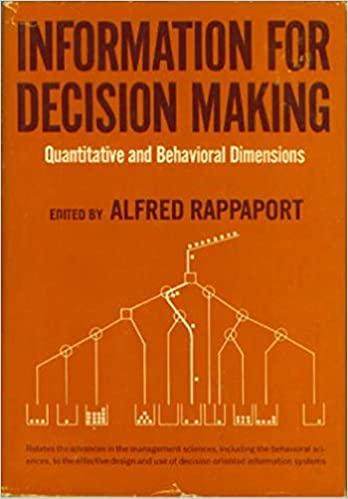Structured Problem Solving, Cash Flows, NPV, Choice of Discount Rate, Advanced Manufacturing Environment Brindon Thayn, president and owner of Orangeville Metal Works, has just returned from a trip to Europe. While there, he toured several plants that use robotic manufacturing. Seeing the efficiency and success of these companies, Brindon became convinced that robotic manufacturing is essential for Orangeville to maintain its competitive position. Based on this conviction, Brindon requested an analysis detailing the costs and benefits of robotic manufacturing for the materials handling and merchandising equipment group. This group of products consists of such items as cooler shelving, stocking carts, and bakery racks. The products are sold directly to supermarkets. A committee, consisting of the controller, the marketing manager, and the production manager, was given the responsibility to prepare the analysis. As a starting point, the controller provided the following information on expected revenues and expenses for the existing manual system: avariable cost detail (as a percentage of sales): b $20,000 is depreciation; the rest is cash expenses. Given the current competitive environment, the marketing manager thought that the preceding level of profitability would not likely change for the next decade. After some investigation into various robotic equipment, the committee settled on an Aide 900 system, a robot that has the capability to weld stainless steel or aluminum. It is capable of being programmed to adjust the path, angle, and speed of the torch. The production manager was excited about the robotic system because it would eliminate the need to hire welders. This was an attractive possibility because the market for welders seemed perpetually tight. By reducing the dependence on welders, better production scheduling and fewer late deliveries would result. Moreover, the robot's production rate is four times that of a person. It was also discovered that robotic welding is superior in quality to manual welding. As a consequence, some of the costs of poor quality could be reduced. By providing better quality products and avoiding late deliveries, the marketing manager was convinced that the company would have such a competitive edge that it would increase sales by 50 percent for the affected product group by the end of the fourth year. The marketing manager provided the following projections for the next 10 years, the useful life of the robotic equipment: Currently, the company employs four welders, who work 40 hours per week and 50 weeks per year at an average wage of $10 per hour. If the robot is acquired, it will need one operator, who will be paid $10 per hour. Because of improved quality, the robotic system will also reduce the cost of direct materials by 25 percent, the cost of variable overhead by 33.33 percent, and variable selling expenses by 10 percent. All of these reductions will take place immediately after the robotic system is in place and operating. Fixed costs will be increased by the depreciation associated with the robot. The robot will be depreciated using MACRS. (The manual system uses straight-line depreciation without a half-year convention and has a current book value of $200,000.)Iftheroboticsystemis acquired, the old system will be sold for $40,000. The robotic system requires the following initial investment: At the end of 10 years, the robot will have a salvage value of $20,000. Assume that the company's cost of capital is 12 percent. The tax rate is 40 percent. You must use the Exhibit 19B.1 and Exhibit 19B.2 present value tables and Exhibit 19.5 to solve the following problems. Required: 1. Prepare a schedule of after-tax cash flows for the manual system. Enter cash outflows as negative amounts and cash inflows as positive amounts. Prepare a schedule of after-tax cash flows for the robotic system. When performing intermediate calculations, round percentages to two decimal places 15.456% rounds to 15.46% ) and round computed amounts to the nearest dollar. Enter cash outflows as negative amounts and cash inflows as positive amounts. 2. Using the schedules of cash flows computed in Requirement 1 , compute the NPV for each system. Round intermediate calculations and your final answers to the nearest dollar. Should the company invest in the robotic system? 3. In practice, many financial officers tend to use a higher discount rate than is justified by the firm's cost of capital. For example, a firm may use a discount rate of 20 percent when its cost of capital is or could be 12 percent. Offer some reasons for this practice. Assume that the annual after-tax cash benefit of adopting the robotic system is $80,000 per year more than the manual system. The initial outlay for the robotic system is $340,000. Compute the NPV using 12 percent and 20 percent. Round intermediate calculations and your final answers to the nearest dollar. If the NPV is negative, enter your answer as a negative value. Would the robotic system be acquired if 20 percent is used? Could this conservative approach have a negative impact on a firm's ability to stay competitive? Present Value of an Annuity of $1 in Arrears" rPn=(1/4)[11/1+0] MACRS Depreciation Rates













